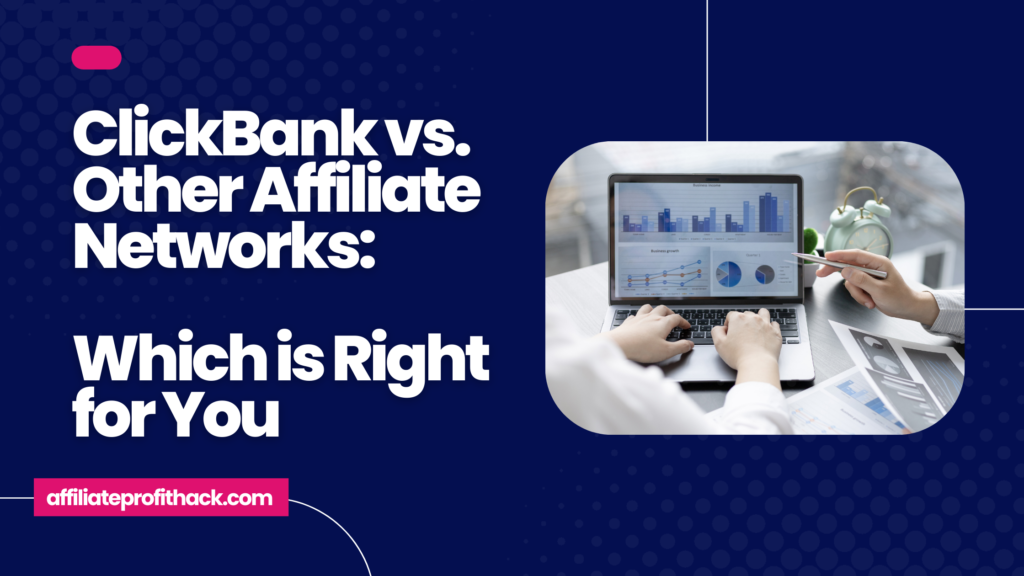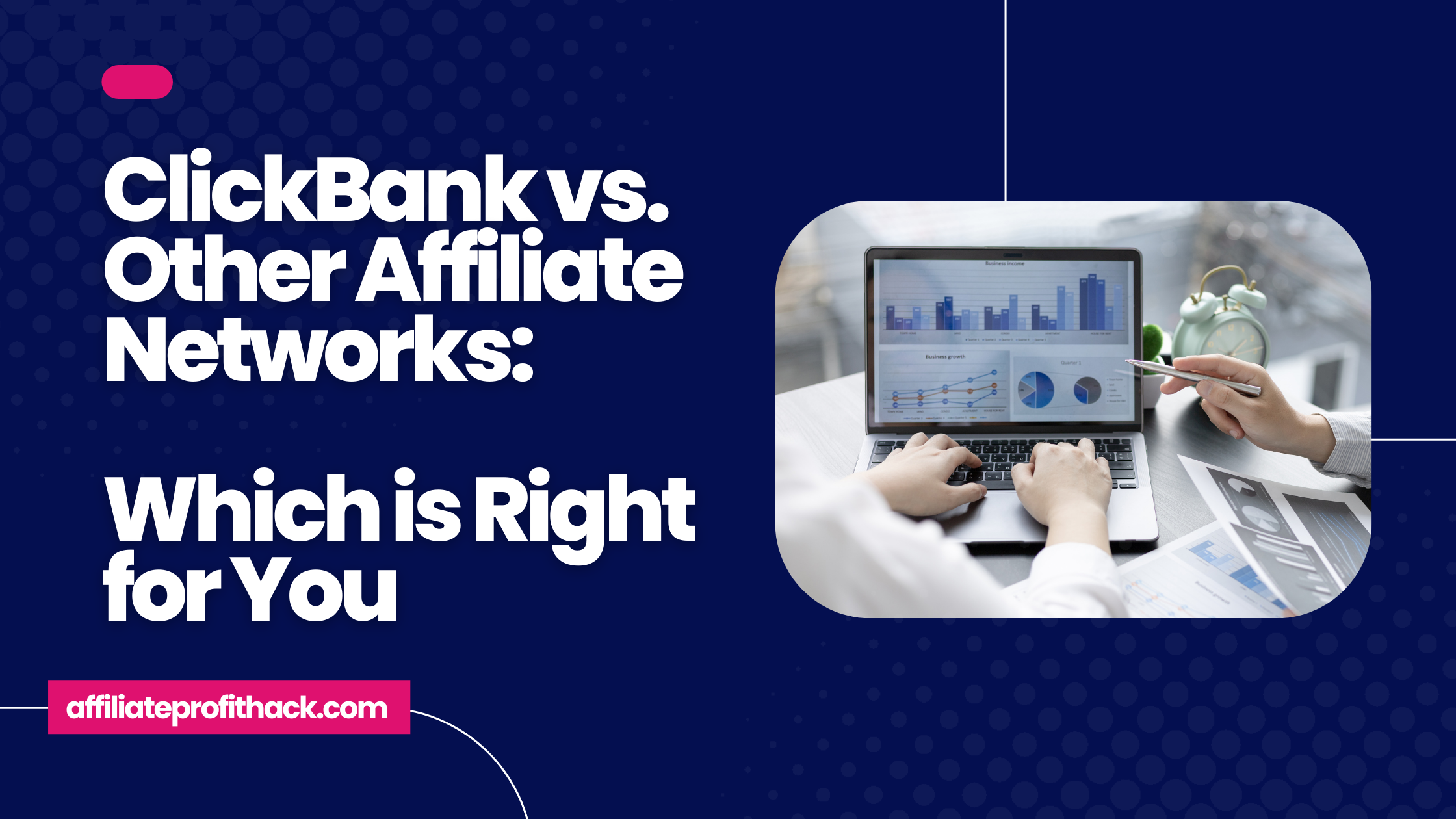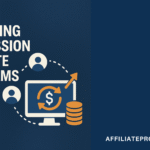Welcome to my article “ClickBank vs. Other Affiliate Networks: Which is Right for You”.
When it comes to affiliate marketing, choosing the right network can feel like picking a favorite streaming service — too many options, and each one promises something different. ClickBank, Amazon Associates, ShareASale, Rakuten… the list goes on, and each platform has its quirks, pros, and cons. For some, ClickBank might feel like the cool, quirky friend who’s all about digital products and high commissions. For others, the trusted, product-packed world of Amazon Associates is more their vibe. So, how do you decide which network fits your style (and budget) best?
In this post, we’ll dive into a comparison of ClickBank and other top affiliate networks, breaking down what each has to offer and who they’re best suited for. By the end, you’ll have a better sense of which platform deserves your loyalty (or at least, your efforts). Ready to find your perfect affiliate match? Let’s dive in — just don’t expect roses and chocolates… unless they’re on your commission list.
My Best Recommended & Proven Way to Make $100-$300 Daily – Watch This FREE Video to START >>>

Overview of ClickBank and Its Unique Selling Points
Let’s start with the basics: what exactly is ClickBank, and why does it have so many affiliates singing its praises? Founded way back in 1998, ClickBank has carved out its niche in the affiliate world, mainly thanks to its focus on digital products. Think e-books, online courses, software subscriptions, and other downloadable goodies. If traditional affiliate networks like Amazon Associates are the malls of the affiliate marketing world, ClickBank is the hip, digital-only marketplace where everyone seems to be selling the latest online success formula.
One of ClickBank’s biggest draws is its commission structure. While other networks might hand over a humble 3-10% commission, ClickBank’s rates are more of a “sky’s-the-limit” type of deal, often ranging between 30% to 70%. Yes, you read that right! With commissions like that, it’s easy to see why affiliates flock to promote its products. Plus, since digital products don’t have manufacturing or shipping costs, merchants are more generous with their payouts, which means more cash in your pocket with each sale. And because ClickBank pays out weekly (not monthly, like some networks), you don’t have to wait around forever for those sweet commissions to hit your bank account.
Then there’s the famous gravity score. Unique to ClickBank, this little number gives affiliates insight into how well a product is selling across the platform. Higher gravity? That means it’s flying off the virtual shelves. For affiliates, it’s like having a “hot or not” meter on the products you’re considering. Gravity helps you avoid duds and focus on what’s already popular — a helpful tool when you’re just starting out and want to know where to invest your energy. So, if you’re looking for a network with high payouts, digital products, and a popularity guide built right in, ClickBank might just be the affiliate partner you never knew you needed.
Comparison of Commission Structures: ClickBank vs. Other Affiliate Networks
Commission structures — the bread and butter of affiliate marketing. It’s what makes all the difference between getting a modest paycheck and cashing in big. And when it comes to commissions, ClickBank isn’t playing around. With commission rates that often soar between 30% to 70% (and yes, sometimes even more!), ClickBank sets a high bar. Why the high rates? Since ClickBank primarily deals in digital products, there’s no need for pesky manufacturing or shipping costs, so vendors can afford to share more of the profits. That means for every sale, affiliates get a nice, hefty cut, often far beyond what other networks can offer.
Compare that to Amazon Associates, and it’s almost like night and day. Amazon’s commissions top out at around 10% (if you’re lucky), with most product categories earning much less. For some affiliates, those lower rates are worth it, thanks to Amazon’s massive selection and high conversion rate — almost everyone trusts Amazon, so it’s not hard to get people clicking and buying. But if your goal is maximizing each sale, Amazon’s modest rates can leave you feeling, well, underwhelmed. Then there’s CJ Affiliate and ShareASale, both of which offer a more mixed bag of commissions, usually hovering around 5% to 20%. It’s decent, especially for physical goods, but rarely as high as ClickBank’s rates.
Another perk unique to ClickBank? Recurring commissions. Many of its products, like software subscriptions or membership sites, offer monthly payouts as long as the customer stays subscribed. So, instead of a one-time payday, you’re looking at passive income rolling in every month — a dream for any affiliate! Not all networks can compete here. While some, like CJ Affiliate, have a few subscription products, it’s not nearly as common.
So, when it comes to pure earning potential, ClickBank’s commission structure makes it a strong contender. Whether you’re aiming for high one-time commissions or the magic of recurring income, it has something to keep your earnings flowing. And if your strategy includes promoting high-value digital products, ClickBank’s structure might just make it a perfect fit.
Types of Products Available: Digital vs. Physical
In the world of affiliate marketing, the types of products you promote can make all the difference in your earnings and strategy. ClickBank is all about digital products — from self-help courses and workout guides to business software and niche e-books. Think of it as the digital marketplace for, well, digital stuff! These products are typically easier to sell online since they’re instantly accessible, and who doesn’t love an instant download? But the real beauty lies in their commission potential: digital products often offer higher payouts because there’s no inventory to worry about, and profit margins are huge.
Meanwhile, other networks like Amazon Associates and Rakuten focus on the realm of physical products. Whether it’s kitchen gadgets, tech gear, or beauty products, these networks have what feels like an endless selection of real, tangible items. Physical products can appeal to a much broader audience — let’s face it, most people are more likely to buy a fitness tracker than an online fitness course. Plus, trusted brands like Amazon make selling physical products easier; almost everyone is comfortable buying from Amazon, so conversions are typically strong. The downside? Lower commissions. Physical products come with production costs, shipping fees, and slimmer margins, which means affiliates usually earn a smaller slice of the pie, often around 1% to 10%.
My Best Recommended & Proven Way to Make $100-$300 Daily – Watch This FREE Video to START >>>
ClickBank’s digital products are great for affiliates targeting niche audiences and topics. Say you’re in the personal finance space — promoting an e-book on debt reduction through ClickBank might be just what your audience needs (and pays you handsomely, to boot). But if you’re in a general lifestyle niche, physical products like home goods or fashion accessories through Amazon or ShareASale could be a better fit.
In the end, it’s about matching your audience with the right type of product. Digital products on ClickBank mean high commissions and instant access for buyers, making them appealing for more niche or info-focused marketing. Physical products through other networks, on the other hand, come with lower commissions but can appeal to wider audiences and offer brand trust. So, whether you’re selling courses or coffee makers, knowing which product type suits your market will help you get the most out of your affiliate efforts.
User Experience and Affiliate Support: Which Platform is Easier to Use?
Let’s be real: no one wants to spend their time wrestling with clunky dashboards or sifting through help docs just to figure out how to get paid. In the world of affiliate marketing, ease of use can be a game-changer, especially if you’re new to the game or juggling multiple platforms. ClickBank, in this regard, shines with a simple, no-frills dashboard and quick setup. Want to find a product, check your earnings, or pull a link? ClickBank’s streamlined interface makes it all fairly painless — a refreshing change if you’re coming from other networks where “user-friendly” sometimes feels like a foreign concept.
For beginners, ClickBank has the added perk of dedicated resources like ClickBank University, an in-house training platform that offers courses on everything from product promotion to scaling strategies. It’s a great starting point for those new to affiliate marketing or anyone who appreciates a little extra guidance. Plus, the platform provides solid affiliate support with responsive customer service and a helpful FAQ section. If you run into a roadblock, chances are, ClickBank’s got a straightforward answer waiting for you.
On the flip side, we have networks like Amazon Associates and CJ Affiliate, which — while powerful — can be a little more complicated to navigate. Amazon Associates, for instance, requires you to apply for each individual tracking ID, and it has stricter guidelines around promotions (those Amazon compliance rules can be a bit daunting at first). CJ Affiliate offers a more comprehensive dashboard with advanced reporting features, which seasoned affiliates might appreciate, but it can feel overwhelming if you’re just starting out. And don’t get us started on payment thresholds and approval processes — with some networks, getting a link or making your first payout can feel like a marathon!
In terms of affiliate support, ClickBank’s dedicated community and resources like ClickBank University really set it apart. Other networks have support, too — Amazon Associates has help pages and a forum, and CJ Affiliate offers a help center and live chat — but ClickBank’s beginner-friendly approach keeps the intimidation factor low. So, if you’re looking for a smooth user experience that won’t have you scrambling to decode dashboards, ClickBank is as close to “plug and play” as it gets in the affiliate world. For the more advanced, detail-oriented crowd, though, platforms like CJ might offer the granularity and options you need, even if it takes a little more getting used to.
Traffic and Marketing Methods: What Works Best on Each Network?
You have picked your affiliate network, and now you’re wondering, “How do I actually get people to click these links?” Traffic is the lifeblood of any affiliate marketing strategy, but the best way to drive it depends a lot on the platform you’re working with. ClickBank, for instance, is a dream for affiliates who favor paid advertising, email marketing, or social media promotion. Because it’s largely digital, ClickBank’s products tend to appeal to audiences looking for instant solutions — think e-books, courses, and software that solve specific problems. This makes it perfect for laser-targeted ads on Google, Facebook, or Instagram, where you can serve up just the right offer to people searching for that very problem.
Email marketing is another win for ClickBank affiliates. Since many products on ClickBank are niche-focused and often come with recurring commission options (like subscription software), a well-targeted email list can become a consistent revenue stream. Plus, ClickBank products lend themselves to high-conversion email strategies, where you can offer value-packed content and gently nudge your audience toward a product. And if you’re into social media, platforms like YouTube or TikTok are gold mines for ClickBank promotions. A quick, value-focused video on a niche topic with a link in the bio can reach thousands of viewers who might be ready to convert right then and there.
My Best Recommended & Proven Way to Make $100-$300 Daily – Watch This FREE Video to START >>>
Then there are physical product-focused networks like Amazon Associates and ShareASale. Here, SEO and content marketing rule the roost. Amazon’s trusted name means that a well-optimized blog post or review page can drive tons of clicks and conversions with minimal extra push. SEO-friendly content like “best of” lists, comparison articles, and in-depth reviews perform particularly well, especially if you’re targeting high-intent keywords like “best blender for smoothies” or “top camping gear 2024.” These types of articles attract readers already in “buying mode,” which pairs perfectly with Amazon’s vast product selection and established reputation.
For CJ Affiliate and Rakuten, a mix of SEO, influencer marketing, and even direct partnerships with other sites works well. These networks often feature household names and popular brands, which makes them ideal for influencer collaborations on platforms like Instagram and YouTube. Many influencers find success by partnering with lifestyle brands on CJ, reviewing or endorsing products that match their followers’ interests. This strategy works particularly well if you’re in a niche like fashion, beauty, or home goods, where visual appeal is key.
So, in a nutshell: ClickBank shines with paid ads, email marketing, and social media promos for its digital, high-commission products. For Amazon Associates and other physical product networks, SEO-rich blog content and comparison reviews pull in the clicks and conversions, leveraging Amazon’s brand trust. And for networks like CJ Affiliate, influencer marketing and content partnerships add credibility to high-visibility brands, making them a favorite for affiliates in lifestyle and retail niches. With the right traffic strategy tailored to the platform, you’re well on your way to seeing those clicks — and commissions — roll in!
Conclusion
After diving deep into the affiliate marketing ocean and weighing ClickBank against its competitors, where do you stand? Ultimately, the choice of network boils down to what you’re looking to achieve and how you plan to engage your audience. If high commissions on digital products, an easy-to-use interface, and a wealth of educational resources sound appealing, ClickBank might just be your golden ticket. With its impressive array of e-books, courses, and software, it’s like a buffet for affiliates who thrive on digital solutions. Plus, the gravity score helps you identify the hot products that are selling like hotcakes, so you can dive right into what’s working without a lot of guesswork.
On the other hand, if your focus leans toward promoting physical products and you thrive in the world of SEO and content marketing, networks like Amazon Associates or ShareASale could be more up your alley. These platforms offer access to an extensive range of tangible goods and a well-established customer base, making them a smart choice for affiliates who want to tap into broader markets. Just remember, while the commission rates may not match ClickBank’s, the trust factor and brand recognition can be a game-changer when it comes to conversion rates.
And let’s not forget the importance of aligning your marketing strategies with your chosen network. Whether you’re crafting killer email campaigns for ClickBank’s digital offerings or optimizing your blog posts for Amazon’s physical products, knowing your audience and tailoring your approach will set you apart from the competition.
My Best Recommended & Proven Way to Make $100-$300 Daily – Watch This FREE Video to START >>>
In the end, there’s no one-size-fits-all answer. It’s all about finding the right fit for your unique goals, audience, and marketing style. So, roll up your sleeves, test the waters, and don’t hesitate to experiment with multiple networks. After all, affiliate marketing is as much about discovering what works for you as it is about making those commissions. Now go out there and find your perfect affiliate match — because the right network is waiting to help you turn those clicks into cash!
Thanks for reading my article “ClickBank vs. Other Affiliate Networks: Which is Right for You” till the end. Hope it helped you. See you with another article.










